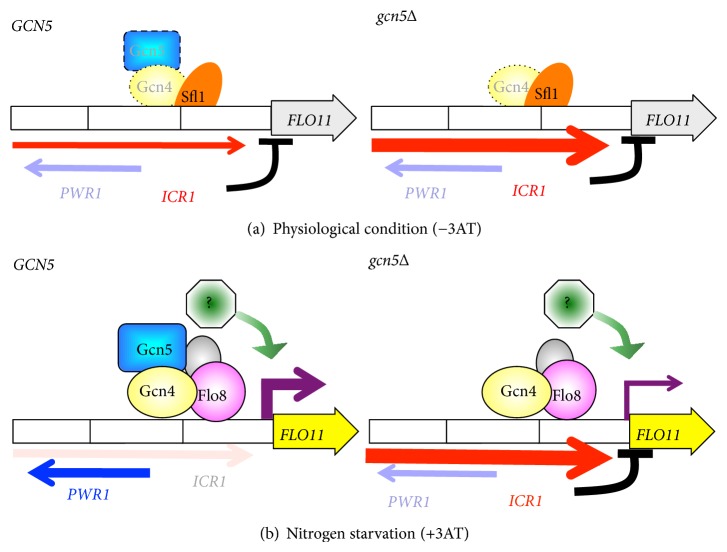Figure 5.
A model of Gcn5-mediated transcriptional regulation of ncRNA ICR1 and FLO11 in diploid yeast. (a) Under physiological conditions (−3AT), the Sfl1 (a repressor, oval in orange) associates with the FLO11 promoter to inhibit the transcription of the ncRNA PWR1, which leads to enhanced transcription of another ncRNA, ICR1, for repressed FLO11 transcription. The reciprocal interference between PWR1 and ICR1 transcription and suppression of FLO11 expression by active ICR1 transcription are adapted from [43]. Without 3AT induction, Gcn5 may be recruited by a marginal level of Gcn4 bound at the FLO11 promoter (left panel). Because deletion of GCN5 enhances ICR1 expression twofold (right panel), Gcn5 may play a role in regulating transcription of the PWR1 and ICR1 independent of 3AT. However, the net transcription of FLO11 is minimal in the WT without 3AT induction. (b) In nutrient stress such as amino acid starvation induced by 3AT (+3AT), a substantial level of Gcn4 and Gcn5 is recruited to the FLO11 promoter. Because of overlapped binding sequences, Gcn4-Gcn5 may collaborate with Flo8 (an activator, circle in purple) to compete with Sfl1 for binding to the toggling sites and activate PWR1 expression to block ICR1 transcription, which then derepresses the expression of FLO11 (left panel). Deletion of GCN5 enhances ICR1 expression and then reduces FLO11 transcription (right panel). Since gcn5Δ diploid yeast still maintains twofold induction of FLO11, a Gcn5-independent factor (octagon in green) is likely involved in FLO11 expression in response to 3AT induction.

